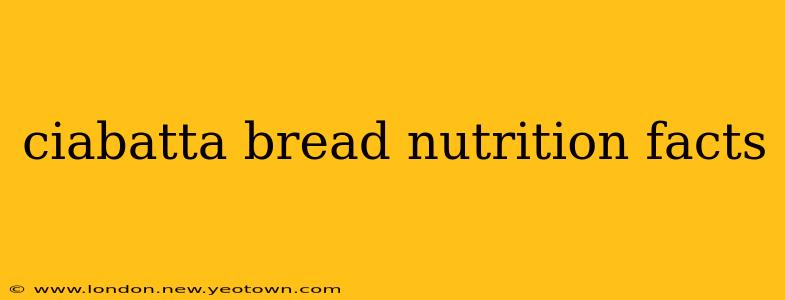Ciabatta, with its airy interior and crisp crust, has become a beloved bread choice for many. But beyond its delightful texture, what's the nutritional story behind this Italian staple? Let's dive into the ciabatta bread nutrition facts and explore its place in a balanced diet.
What are the Nutritional Values of Ciabatta Bread?
A typical slice of ciabatta bread (around 30g) offers a surprisingly varied nutritional profile. While precise values vary based on ingredients and baking methods, you can generally expect to find:
- Calories: Around 70-80 calories per slice.
- Carbohydrates: The majority of calories come from carbohydrates, primarily complex carbohydrates. This provides sustained energy.
- Protein: A moderate amount of protein, contributing to satiety.
- Fiber: Ciabatta, especially when made with whole wheat flour, can be a decent source of fiber, aiding digestion and promoting gut health.
- Fat: Relatively low in fat.
- Vitamins and Minerals: While not a powerhouse of vitamins and minerals, it does offer small amounts of various nutrients like iron and some B vitamins. The nutritional content will be enhanced if whole wheat flour is used.
Is Ciabatta Bread Healthy?
This is a question with a nuanced answer. Ciabatta bread itself isn't inherently unhealthy, but its healthfulness depends greatly on several factors:
- Type of Flour: Ciabatta made with refined white flour will be lower in fiber and nutrients compared to ciabatta made with whole wheat flour or other whole grains. Whole grain versions are generally considered healthier.
- Added Sugars and Fats: Some commercially produced ciabatta may contain added sugars and unhealthy fats, which negatively impact its nutritional profile. Opting for bread made with simple ingredients is key.
- Portion Size: Like any bread, overconsumption of ciabatta can lead to excessive carbohydrate intake and potential weight gain. Enjoying it in moderation as part of a balanced diet is crucial.
How Does Ciabatta Compare to Other Breads?
Compared to other breads, ciabatta often sits somewhere in the middle. It's generally less dense than sourdough and provides more air pockets, which can make it feel lighter in the stomach. Its nutritional profile is comparable to many other breads, with variations based on the ingredients used.
Is Ciabatta Bread Gluten-Free?
No, traditional ciabatta bread is not gluten-free. It is made from wheat flour, which contains gluten. Individuals with celiac disease or gluten intolerance should avoid ciabatta. However, gluten-free alternatives are increasingly available in bakeries and stores.
What are the Benefits of Eating Ciabatta Bread?
While not a "superfood," ciabatta bread, particularly whole-wheat varieties, offers some potential benefits:
- Source of Energy: The carbohydrates provide sustained energy for daily activities.
- Fiber Content (Whole Wheat): Promotes healthy digestion and helps maintain regular bowel movements.
- Versatile in Cooking: Its texture makes it ideal for various culinary applications, from sandwiches to bruschetta.
Can You Make Ciabatta Bread at Home?
Yes, absolutely! Many home bakers find making ciabatta a rewarding experience. Numerous online recipes guide you through the process, offering variations for different preferences. The slightly more complex technique often produces exceptionally flavorful results.
What are the potential downsides of eating Ciabatta Bread?
The main potential downsides are related to:
- High Glycemic Index (depending on the type of flour): Refined white flour ciabatta can cause a rapid spike in blood sugar levels.
- Allergies: Those with wheat allergies or gluten intolerance must avoid ciabatta entirely.
- Added Ingredients: Watch out for added sugars, unhealthy fats, and preservatives.
In conclusion, ciabatta bread can be a delicious and satisfying part of a healthy diet when chosen wisely. Prioritize whole-wheat options with minimal added ingredients, and enjoy it in moderation as part of a balanced meal plan.

